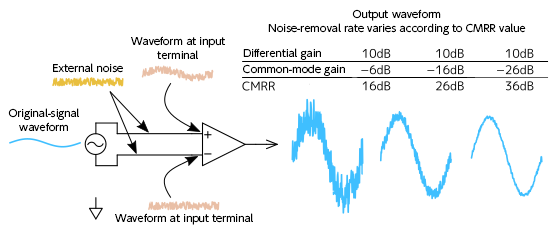Posted 2019/7/19
Noise equally appearing on the two transmission lines is called “common-mode noise” hereafter. It has various causes like humming noise derived from the commercial power supply and electromagnetic waves. (Figure 1)
In the case of single-line grounding, it is impossible to separate the original signal from the external noise. For that reason, efforts to reduce external noise, such as shortening the signal line, using a shielded wire, and keeping the original signal away from the noise source, are indispensable.
Figure 1

On the contrary, in the case of the differential system, the common-mode signal can be removed by utilizing the effect of differential gain and common-mode gain. It is clear that the external noise (which is an in-phase signal) can be removed as the common-mode gain is decreased (or common-mode rejection ratio is increased) (Figure 2).
The mechanism by which the differential circuit removes common-mode noise is called “common-mode rejection” (CMR). Also, the magnitude of noise removed by CMR is the same as common-mode gain with the opposite sign, so it is sometimes used in the sense of common-mode gain. For example, 1 Vp-p is input as the in-phase signal to the preamplifier input with CMR of 40 dB. The output at that time is 10 mVp-p (namely, reduced by 1/100 to gain of -40 dB).
The ratio of the differential-signal output and the in-phase-signal output is called “common-mode rejection ratio” (CMRR).
To effectively use the differential method, it is necessary to pay attention to the wiring so that the external noise overlaps both of the differential signals equally. Noise superimposed on only one side of the differential signal cannot be removed (as in the case of single-wire grounding).
Figure 2

Related keywords : Ultra low noise amplifier, LNA